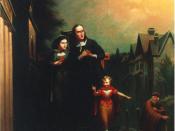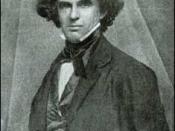A PuritanÃÂs FollyÃÂNever forget that only dead fish swim with the stream.ÃÂ -Malcolm Muggeridge. This famous quote justifies that to be an individual, one must break from society and think for himself, and only when he has done this, is he truly alive. Nathaniel HawthorneÃÂs novel The Scarlet Letter is about a courageous woman, Hester Prynne, and her struggle to split from society in order to live the loving life she has always wanted. By the use of symbolism, Hawthorne is effectively able to portray the forest, which promotes individuality, and the town, which rewards conformity. The clothes portrayed by the Puritans, the town, are dull and plain whereas those expressed by the Romantics, the forest, are vivid and eccentric. Also, the various events of the novel contrast from cold and punishing with the Puritans to hopeful and exciting with the Romantics. Finally, the characters representing the Romantics are passionate and carefree whereas those of the Puritans are serious and punishing.
Because the Romantic ideas incorporate an enjoyable, fulfilling life whereas the Puritan ideas incorporate a cold and punishing life, it is evident that Hawthorne is trying to spread the thought of individualism, a quality greatly promoted in the Romantic lifestyle, through his novel.
Throughout the novel, Hawthorne continues to show the clothes of the Romantics as vivid and eccentric and the clothes of the Puritans as plain and dull in order to spread his underlined theme of individuality. The people of the town wore very unadorned and dull clothes, lessening their opportunity of individuality. In order to be complete servants of God, the townsÃÂ people wore clothes ÃÂ{of} a coarser fibreÃÂ (48). They did this in order to not make themselves appear like they were better than God, rather much lower of an individual than he. By doing this, the people of the town clumped together to form a society ruled by only one opinion. In consequence the ruling of the society brought devastation and pain to those who tried to express their individual ideas, eventually leading to death or public humiliation. Also, HesterÃÂs clothes act as a transition between the Puritan and Romantic beliefs, for although she wears the emblem of humiliation, the scarlet letter, she lavishes it up with extravagant detailing. Although Hester was forced to wear the Scarlet ÃÂAÃÂ on her bosom, she used her needlework to ÃÂadd the richer and more spiritual adornment of human ingenuityÃÂ to the once plain emblem (75). This shows that, although she still confides with the town to ware the mark of shame, she still tries to break free and make the mark her own. This scene is significant for it begins to portray HawthorneÃÂs universal theme of individuality. In consequence, the people eventually replace the meaning of HesterÃÂs scarlet letter from that of adulterer to that of able. Finally, Pearl becomes the complete symbol For the Romantics when she garnishes herself with ornaments of the forest. As Pearl and Hester are on a walk, ÃÂPearl {takes} some eel grassÃÂ and adorns herself with it (161). This shows that Pearl wears clothes of a free spirit like that that the forest represents. This scene is significant for it portrays the true individual, one who does for himself not what others do, in Pearl. In consequence, the reader begins to see a transformation in Pearl, from a symbol, arguably, of the devil, to that of the true individual. By observing HawthorneÃÂs depictions of the clothes used throughout his novel, it is obvious that he is telling the reader to break from society and become an individual.
Hawthorne contrasts the events in the novel from cold and punishing with the Puritans to hopeful and exciting with the Romantics in order to further show that the Romantic beliefs are greater than that of the Puritans. In the beginning of the novel, the townÃÂs true, punishing personality is expressed as they sentence Hester Prynne, a young woman who has committed adultery, to public humiliation among the scaffold. As the members of the town see young Hester suffering an untold of punishment, they still wish her dead for she has ÃÂbrought shame upon [them] allÃÂ (49). Even after the town has unfairly punished Hester, they still wish to punish her more. This signifies the cold and unjust nature of the Puritans, who want nothing more than strict laws and harsh punishment. In consequence, Hester refuses to show that the town has broken her and continues to keep her pride and remain dignified. In addition, the act when Dimmesdale mounts the scaffold to relieve himself of his guilt, serves as a transition between the town and forest, for although he is splitting from society, his is doing so in the confines of his own knowledge, not making it public. DimmesdaleÃÂs ascend of ÃÂthe guilty platformÃÂ serves as a remedy for his suffering for prior seven years (137). Although the act does not fully relieve him of his pain, as it should not, it gives him an excuse to keep moving on. This event shows that Dimmesdale is a weak and cowardly man, not yet strong enough to confess his sins, therefore forced to relieve his pain in this cowardly fashion. This event foreshadows that when Dimmesdale finally enlightens the town of his past adulteries, relieving him entirely of his guilt. Lastly, their confrontation in the forest allow Hester and Dimmesdale the freedom to express their true feelings towards each other. As they sat next to each other, ÃÂhand clasped in hand, on the mossy trunk of the fallen treeÃÂ Hester and Dimmesdale were finally able to express their love and plan their escape from the horrid society of hypocritical Puritans (176). This event marked the first in seven years since the couple could express their feelings and communicate freely. This event expresses the complete Romantic ideas; sharing love, becoming individuals, and splitting from the Puritan lifestyle. In consequence the couple undergo the complete transformation from Puritans to Romantics, stressing HawthorneÃÂs underlined message of individualism as they convert. Because Hawthorne shows the Romantic events as loving and hopeful episodes, whereas he illustrates the Puritan events as cold and punishing affairs, he is further showing the importance of a Romantic lifestyle in relative to the Puritan lifestyle.
Hawthorne portrays the characters of the Romantics as passionate and carefree whereas he portrays those of the Puritans as punishing and serious. Roger Chillingworth, HesterÃÂs husband who was left behind in England when Hester ventured out to America, serves as an evil antagonist in the novel, constantly tormenting pour old Dimmesdale. As Chillingworth transforms himself from the once kind doctor Hester had married into the evil, revengeful person now hated by all, he effectively ÃÂtransformed himself into the devilÃÂ (153). Chillingworth is the complete symbol of the Puritans, ruthless, punishing, and relentless. As the devil, he serves as the relentless adversary who tortures Dimmesdale to his death. In consequence, once Dimmesdale has died, he feels his life has no purpose and therefore he, himself, ceases to live. The death of the minister symbolizes the final demolition of the Puritan religion, therefore expelling the devil. Hester Prynne serves as a transition character between the Puritans and Romantics, for although she tries to split from the dreary society and start a loving relationship, when caught, she confides back with the church in fear of GodÃÂs wrath. Although Hester tries to completely split from the Puritan code, her most notable mark is still ÃÂ[her] badge of shameÃÂ (101). Instead of making a complete break from the church, she still continues to wear the scarlet letter. This signifies that she continues to confide with the church in hopes that she will one day be able to live life as an individual in heaven. With these hopes Hester carries out her life continuing to wear the scarlet letter until death. Finally, because of her carefree attitude towards life, Pearl becomes the complete character of the Romantics. As Pearl came across the brook, it ÃÂreflected a perfect image of her little figure, with all the brilliant picturesque of her beauty, in its adornment of and wreathed foliage, but more refined and spiritualized than the realityÃÂ (187). This quote is explaining Pearl as she walks through her kingdom, the forest. With the will to now think freely and express her joyful attitude, Pearl now lets her imagination overpower her as she walks among her kingdom. In consequence, we now see Pearl as a beautiful girl who has become one with nature. Because Pearl, representing the Romantic beliefs, has become an individual, free thinker, whereas Chillingworth, representing the Puritan beliefs, has ceased to live, it is evident that Hawthorne id trying to preach the ideas of Romanism and ultimately individualism.
Because Romanticism symbolizes a life of enjoyment and self-pleasure whereas Puritanism symbolizes a life of cold and punishment, it is evident that Hawthorne is trying to spread the thought of individualism, a quality greatly promoted in the Romantic lifestyle. The clothes portrayed by the Puritans are dull and plain compared to the vivid and eccentric clothes worn by the Romantics. Also, the cold and punishing events of the Puritans contrast to the hopeful and exciting events of the Romantics. Finally, the characters representing the Romantics are passionate and carefree whereas those of the Puritans are serious and punishing. Without individual opinion, our society would become one ruled strictly by one voice, eventually leading to the hypocrisy which corrupted the Puritan civilization.
BibliographyThe SCARLET LETTER, NATHANIEL HAWTHORNE, LONDON:PUBLISHED J.M. DENT & SONS Ltd.. NEW YORK, E.R. DUTTON & CO





